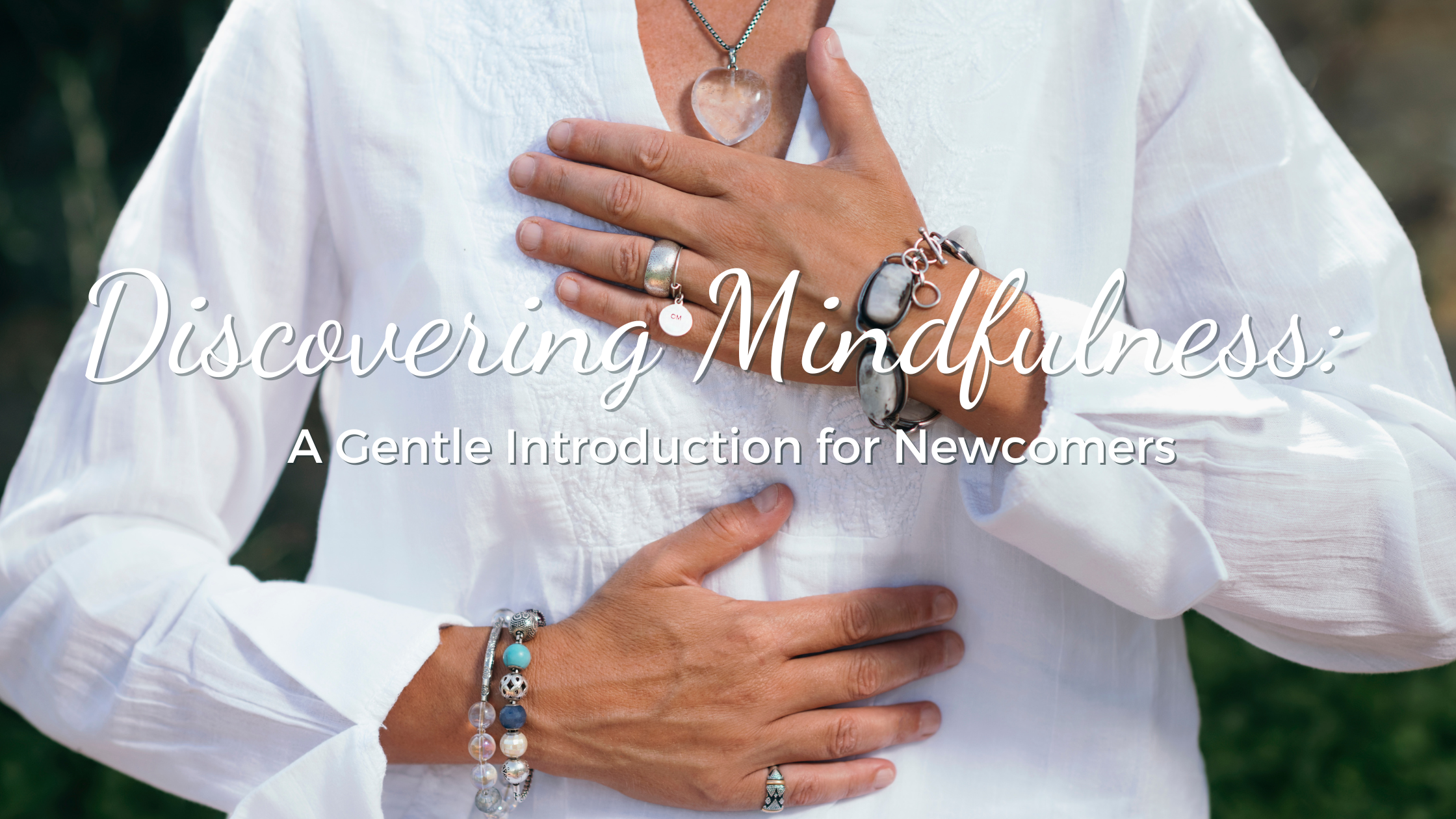Discovering Mindfulness: A Gentle Introduction for Newcomers
Hello there, it's me, Kim, your mindfulness guide on this tranquil journey to understanding mindfulness and its profound benefits for newcomers. In this blog, we'll explore what mindfulness truly means and how it can enhance your well-being, especially if you're new to this practice.
Understanding Mindfulness: A Deeper Dive
Let's begin by unravelling the essence of mindfulness. At its core, mindfulness is about being fully present in the moment, without judgment. It's about embracing the here and now with open arms, whether you're savouring the taste of your morning tea or feeling the warmth of the sun on your face during a walk in the park. Mindfulness is not just a practice; it's a way of life that allows you to reconnect with yourself.
Mindfulness Techniques for Beginners: Breath Awareness and Body Scans
For newcomers, the journey into mindfulness can start with simple yet powerful techniques. One of my personal favourites is breath awareness. It's like an anchor that keeps you grounded in the present moment. When you breathe in, you're aware that you're breathing in, and when you breathe out, you're aware that you're breathing out. It's that simple, yet it can work wonders for reducing stress and anxiety.
A Gentle Guide to Breath Awareness
Breath awareness is like a gentle friend, guiding you into the realm of mindfulness. It's a practice that requires nothing but your breath and your presence. Whether you're new to mindfulness or a seasoned practitioner, this simple yet powerful technique can help you connect with the present moment and reduce stress.
Step 1: Find a Comfortable Space: Begin by finding a quiet and comfortable place to sit or lie down. Ensure that your posture is relaxed yet upright, with your back straight and your hands resting comfortably in your lap or on your knees.
Step 2: Close Your Eyes (Optional): Closing your eyes can help you focus your attention inward and reduce distractions. However, if you're more comfortable with your eyes open and softly gazing at a fixed point, that's perfectly fine too.
Step 3: Tune into Your Breath: Take a moment to simply observe your breath as it naturally flows in and out of your body. There's no need to change your breath; just notice it as it is. Pay attention to the sensation of the air moving in and out of your nostrils or the rise and fall of your chest or abdomen.
Step 4: Focus Your Attention: As you continue to breathe, gently direct your attention to your breath. You can choose a specific aspect of your breath to focus on, such as the sensation of the breath at the tip of your nose or the gentle expansion and contraction of your abdomen.
Step 5: Be Present: Your mind may wander, and that's okay. It's natural for thoughts to arise. When you notice your mind drifting to thoughts, gently and non-judgmentally bring your focus back to your breath. Each time you do this, you're strengthening your mindfulness muscle.
Step 6: Practice Patience and Kindness: Be patient with yourself. It's normal for your mind to wander frequently, especially when you're just starting. Remember that mindfulness is about observing without judgment. Approach yourself and your thoughts with kindness and understanding.
Step 7: Set a Timer: You can start with just a few minutes of breath awareness and gradually extend the duration as you become more comfortable. You might find it helpful to set a timer so you can fully immerse yourself in the practice without worrying about the time.
Step 8: Conclude Mindfully: When your practice time is up, take a few deep breaths and slowly open your eyes if they were closed. Take a moment to notice how you feel. You might find a sense of calm, clarity, or relaxation.
Breath awareness is a simple yet profound mindfulness practice that you can incorporate into your daily life. Regular practice can help you become more grounded, reduce stress, and cultivate a deeper connection with yourself and the present moment. As you continue to explore this practice, remember that it's a journey, and each breath is an opportunity to be fully alive and aware.
Another technique that's perfect for beginners is the body scan. It involves mentally scanning your body from head to toe, paying attention to any tension or discomfort. It's an excellent way to tune into the physical sensations that often go unnoticed in our busy lives.
A Gentle Guide to the Body Scan
A body scan is a mindfulness practice that allows you to tune into the sensations in your body, promoting self-awareness and relaxation. It's a powerful tool for reducing stress and cultivating mindfulness.
Step 1: Find a Comfortable Space: Begin by finding a quiet and comfortable place to sit or lie down. Ensure that your posture is relaxed, with your back straight and your hands resting comfortably in your lap or on your knees.
Step 2: Close Your Eyes (Optional): Closing your eyes can help you focus your attention inward and reduce external distractions. However, you can also practice the body scan with your eyes open if you prefer.
Step 3: Start at the Feet: Direct your attention to your feet. Begin by noticing any sensations in your toes, the soles of your feet, and your heels. Pay attention to warmth, tingling, tension, or any other sensations you may feel.
Step 4: Move Upward: Slowly move your attention up your body, one part at a time. Notice the sensations in your ankles, calves, knees, and thighs. Continue to observe without judgment, as if you're gently scanning each area with your awareness.
Step 5: Be Present: As you scan each body part, be fully present with the sensations you encounter. If you encounter areas of tension or discomfort, simply observe them without trying to change anything. Mindfulness is about non-judgmental awareness.
Step 6: Continue to the Upper Body: Proceed to scan your abdomen, chest, back, shoulders, arms, and hands. Take your time with each area, and if your mind starts to wander, gently guide it back to the sensations in your body.
Step 7: Observe Your Neck and Head: Finally, bring your attention to your neck, throat, face, and head. Notice any sensations in your neck muscles, your jaw, your cheeks, and the top of your head.
Step 8: Full-Body Awareness: Once you've scanned your entire body, take a few moments to expand your awareness to your body as a whole. Feel the connection between different body parts and the overall sensation of being present in your body.
Step 9: Conclude Mindfully: To conclude the body scan, take a few deep breaths and slowly open your eyes if they were closed. Take a moment to notice how you feel. You might experience a sense of relaxation, groundedness, or heightened awareness.
The body scan is a valuable mindfulness practice that can help you connect with your body, reduce stress, and foster a deeper sense of self-awareness. Regular practice can enhance your ability to stay present and mindful in your daily life, improving your overall well-being. Remember, this practice is about self-observation without judgment, allowing you to become more in tune with your body and its sensations.
Incorporating Mindfulness into Daily Life: Practical Tips
Now, let's talk about how you can make mindfulness a part of your everyday routine. Remember, it doesn't have to be complicated or time-consuming. Start by setting aside a few minutes each day for mindfulness practice. It could be in the morning, during lunch, or before bedtime.
During daily activities like eating, walking, or even washing dishes, try to do them mindfully. Focus on the sensations, the textures, the flavours. For instance, when you're eating, savour each bite, and be fully present with your meal. This can turn a mundane activity into a moment of mindfulness and reduce stress in the process.
Nature's Role in Mindfulness: Finding Serenity Outdoors
Nature has a profound connection with mindfulness. Being in nature can be a powerful way to practice mindfulness. Take a leisurely walk in the park or a hike in the woods. Feel the earth beneath your feet, listen to the rustling leaves, and inhale the fresh air. Nature has a way of grounding us and bringing us into the present moment effortlessly.
I often encourage my clients to try mindful photography in nature. It's a beautiful way to blend mindfulness with creativity. Pick up your camera or even your smartphone, and focus on capturing the beauty of the natural world. It's not about getting the perfect shot; it's about truly seeing the world around you.
Measuring Progress in Mindfulness: Tracking Your Journey
As you embark on this mindfulness journey, it's essential to recognize and celebrate your progress. Keep a journal to jot down your thoughts and experiences. Reflect on how you felt before and after a mindfulness session or a mindful walk in nature. Did you notice any changes in your mood, stress levels, or overall well-being?
You can also use stress scales or questionnaires to gauge your progress. These tools can provide valuable insights into the positive impact of mindfulness on your mental health. And remember, it's not about perfection; it's about progress.
In conclusion, mindfulness is a gentle yet transformative practice that can enhance your well-being in countless ways. Whether you're starting with breath awareness, exploring nature, or simply being present in your daily activities, the journey of mindfulness is a personal one, and it's filled with discoveries waiting to unfold. So, take the first step, breathe, and embrace the beauty of the present moment on your path to a more mindful and serene life.

